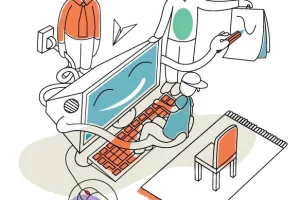The guide Educating for digital Awareness between the ages of 5 and 8: educational paths for teachers and parents is designed for both teachers and parents, as digital challenges and children's rights in the connected world are a shared responsibility of the entire community. Consistent messages are needed to help children grow into digital citizens who are aware of their rights and capable of using online technologies responsibly and critically.
The guide is divided into three chapters, addressing the challenges of the digital world for children aged 5 to 8, providing resources for teachers in preschool and primary education, as well as for parents. The digital educational tools proposed in the guide include:
- The connected world for children aged 5 to 8: Introduces and examines early approaches to the internet, services, and devices, offering an analysis of all elements that provide valuable opportunities to discuss digital issues. It also explores children's digital rights and regulations, such as the European Digital Services Act, which ensures safe digital environments.
- Digital skills in schools: How can digital learning activities be designed and implemented for this age group? How can educators follow ministerial guidelines while ensuring that digital learning is not a separate moment but is instead integrated into subjects and skill development? Practical resources and methods for designing classroom learning activities to promote digital citizenship.
- Parents’ special section: A chapter dedicated to parents with suggestions on key topics relevant to young children, such as privacy, rules, and more. Also with resources for an active and effective dialogue about digital environments.
The guide was created by Save the Children as part of the Safer Internet Centre (SIC) – Generazioni Connesse project, coordinated by the Ministry of Education and Merit and co-financed by the European Commission. It is part of the broader European commitment to a "Better Internet for Kids".
About this resource
The guide Educating for digital Awareness between the ages of 5 and 8: educational paths for teachers and parents is designed for both teachers and parents, as digital challenges and children's rights in the connected world are a shared responsibility of the entire community. Consistent messages are needed to help children grow into digital citizens who are aware of their rights and capable of using online technologies responsibly and critically.
The guide is divided into three chapters, addressing the challenges of the digital world for children aged 5 to 8, providing resources for teachers in preschool and primary education, as well as for parents. The digital educational tools proposed in the guide include:
- The connected world for children aged 5 to 8: Introduces and examines early approaches to the internet, services, and devices, offering an analysis of all elements that provide valuable opportunities to discuss digital issues. It also explores children's digital rights and regulations, such as the European Digital Services Act, which ensures safe digital environments.
- Digital skills in schools: How can digital learning activities be designed and implemented for this age group? How can educators follow ministerial guidelines while ensuring that digital learning is not a separate moment but is instead integrated into subjects and skill development? Practical resources and methods for designing classroom learning activities to promote digital citizenship.
- Parents’ special section: A chapter dedicated to parents with suggestions on key topics relevant to young children, such as privacy, rules, and more. Also with resources for an active and effective dialogue about digital environments.
The guide was created by Save the Children as part of the Safer Internet Centre (SIC) – Generazioni Connesse project, coordinated by the Ministry of Education and Merit and co-financed by the European Commission. It is part of the broader European commitment to a "Better Internet for Kids".
About this resource
- Parenting Tips role of parents school school-activities Teacher Training
Related content
- < Previous resource
- Next resource >
- < Previous
- Next >






